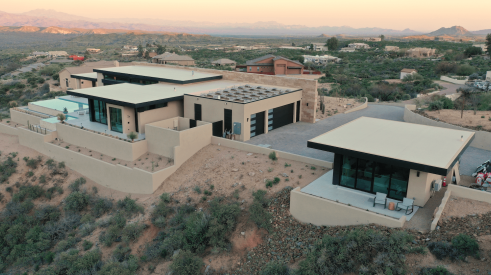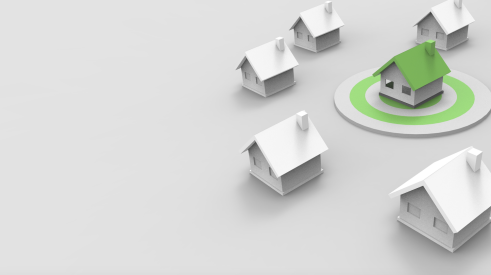|
Looking for a way to sell houses in a bad market? Green building is a powerful weapon to differentiate your shiny new product from all those existing homes sporting "for sale" signs or the bland sea of sameness in competitive new-home subdivisions.
Green-built houses, neighborhoods and master-planned communities meet an emerging market head-on with a product that really is different. The best green home builders and developers find buyers — even when they're hiding — with marketing concepts that create urgency to buy out of America's fear of economic peril, health hazards and impending environmental calamity. Here's how they do it.
Why Green Is Different TodayBuilding a green home has been around for more than a decade, but it's only in the last few years that it found real traction in the marketplace. Why?
It might be one more example of a fundamental change in American lifestyles caused by the continuing upward spiral of energy costs. And the epidemic of asthma and allergies afflicting so many Americans might have something to do with it. Whatever the reasons, green-built houses are becoming almost as hot as hybrid cars. And green communities are attracting mainstream home buyers all across the country, not just tree-huggers in Boulder.
Successful green builders hang their marketing efforts on energy cost savings. The payback from reduced monthly heating and air conditioning bills overtakes the higher upfront cost of building green in only a few years. Improved indoor air quality is the other attribute that virtually all green builders tout. For the thousands of families fighting allergies or asthma, it's probably the most important factor driving their decision to buy a new home. What price do you put on the health of a child? But there's more behind the recent upswing in green home building than those two lynchpin attributes: bushel baskets of marketing dollars, for one thing.
Adam Brunning, general sales manager at Tributary — a 1,400-acre master-planned, traditional neighborhood design (TND) community in the Atlanta market — uses green building as the primary differentiator that drives sales in his community. "We require every builder — and every home — to be EarthCraft-certified," he says. "No other developer in Atlanta has made the commitment to go totally green with every home. And we sell that difference hard on our Web site and in our advertising."
  Lakewood Ranch, near Bradenton, Fla., with 8,500 acres claims title of nation's largest certified green community. The benefits of green are promoted by using displays in their 2,400 square-foot information center. Top photo shows their display of different types of home insulation for varying levels of energy efficiency. |
EarthCraft House is the Atlanta Home Builders Association's landmark green building program, developed in conjunction with the NAHB Research Center. Based on a point system, it allows builders to qualify for certification by piling up points in categories ranging from site planning to tightness of the building envelope, from HVAC systems to water conservation. Home builder associations in neighboring cities and states are now adopting EarthCraft.
"There's a third-party endorsement aspect to this," says Hedgewood Properties' Pam Sessions, who chaired the Atlanta HBA committee that developed EarthCraft. "It's a self-certifying program, but the standards are set across the local industry. And Energy Star falls out of EarthCraft, and that's certified by the (federal) Department of Energy."
Sessions points out that EarthCraft is not a tough bar to reach. The standards were designed to allow 80 percent of production-built homes to qualify. "When you focus on installation and craftsmanship of construction techniques, it doesn't add a lot of cost," she says. "Our buyer surveys show customers believe the value added is worth the investment they make. It pays for itself over time."
Hedgewood and five other EarthCraft builders were part of a recent year-long radio ad campaign that made EarthCraft a recognized household name in Atlanta.
"We've been selling houses for two years," Brunning says, "and about a year ago, we held a focus group of home owners and asked what made them buy in Tributary. John Rymer moderated it. He listed 10 attributes and asked the group to rank them. One woman held up her hand and said, 'You missed something critical. EarthCraft is not on your list!' Every member of that focus group then listed EarthCraft in their top three reasons for buying."
Rymer, a Tampa-based marketing consultant and Professional Builder columnist, has conducted focus groups on green building for nearly a decade. "Everybody always loved the idea of green," he says, "but five years ago, they weren't willing to give up much to achieve green. That's not true anymore."
He believes large-scale green building programs like EarthCraft, combined with the urgency created by rising energy costs and indoor air-related health issues, are responsible for the new traction of green building in the market. "EarthCraft has become a brand in Atlanta, like Energy Star in other parts of the country," Rymer says. "When a builders' association gets behind such a program and then harnesses the marketing clout of major product manufacturers as sponsors, you can develop advertising budgets big enough to get identity in the market so that people will shop looking for that logo."
The amount of money it would take for an individual builder to achieve that branding impact would be excessive, Rymer reasons.
There's another benefit from large-scale advertising of programs like EarthCraft in Atlanta and others taking root in cities across the country. They allow communities like Tributary to draw like-minded buyers, interested in green, from across a broad geographic market. Brunning describes his buyers as Generation X families and says they come from all around Atlanta. "They are very proud of the EarthCraft green classification of their homes," he says. "That's why they came here."
"What you're dealing with is a principle-based buyer," Rymer says. "Young professionals with kids — the kind of people who drive Volvos. This is a significant, growing, but underserved niche. They are receptive to bundling all these attributes like energy efficiency and indoor air quality and sustainability under the label 'green.' They will sacrifice square footage to have a higher quality home, and for them, a brand like EarthCraft becomes almost like the Good Houskeeping Seal of Approval. They equate green to a broader concept of quality."
This is not just an Atlanta phenomenon. Bill Kreager, principal of the Seattle-based architectural firm Mithun, says he does nothing but sustainable projects. "We are totally focused on designing green building communities," he asserts. "We're doing a lot of four-star Built Green housing, which is the Pacific Northwest standard, and we're turning away work."
Branded GreenKreager says builders and developers are branding themselves as green, and many master-planned communities now require four-star certification as the entry level for a home builder to be allowed in the community.
In Bradenton, Fla., Lakewood Ranch is an 8,500-acre master-planned community where every house is certified by the Florida Green Building Coalition's Green Home Standard. It has also been certified as a green community.
"We got our green certification in 2005," says Sondra Guffey, vice president of communications and marketing. "But we've really always been green." She believes it's much easier for a large community to market green than it is for an individual builder, "especially when you get beyond energy efficiency and healthy house attributes and into sustainability."
It's hard for a builder to fund a marketing budget large enough to establish a green identity, she says. But Lakewood Ranch has the resources to do it.
The Sales ChallengeProbably the biggest marketing challenge green builders face — especially those in the production building arena — is training a sales force to sell the complex attributes of green.
"Often, even the best sales people struggle with explaining the science of home systems performance," says Rymer. "If the discussion lasts more than three minutes, they may be out of their league."
The solution, he says, is really good displays in the model homes that sales people can use to stay on track, and collateral materials for shoppers to take with them when they leave.
"If there's a shortcoming of the EarthCraft program in Atlanta, it's probably that too few builders are giving their sales people the training they need to discuss these issues with shoppers," says Pam Sessions. But she believes it's not as hard as it may seem. "The issues and some of the technology can be complex," she admits. "But all the sales people really need to focus on are the benefits. And that has a payoff. The customers start using that benefits list for comparison shopping."
Atlanta-based Ashton Woods Homes builds across the country under Masco's Environments for Living certification program, which allows it to also meet Energy Star requirements. Vice President of Sales and Marketing Tad Serbin admits most of his sales agents don't like to talk about complex building science issues, but he trains them to use large displays in the model homes.
"In our sales offices, we have large boards with bullet points that show how the construction process; heating and cooling equipment; moisture management systems; fresh air ventilation; and pressure balancing work together," he says. "We also have a collateral piece on Environments for Living that visitors can take with them."
He leaves strategy to the salespeople, but they train constantly on the Environments for Living story. "We role play and make them go over and over it," Serbin says. "We also have that story in great detail on our Web site. It's something we stress as a differentiator against competitors."
Rymer emphasizes keeping it simple. "Sell the benefits to the buyer rather than features of individual components of a system," he says. "A safe, healthy, energy-efficient home is easier to sell than a tankless water heater or foam insulation."
Ashton Woods sales rep Chris Hartley sells townhouses in Colorado Springs, Colo. He admits that when he came to The Townes at Kettle Creek from another builder in Kansas City, he'd never heard of green building or the Built Green Colorado certification program his product meets. "This is our first project in Colorado, but because we build to the Environments for Living gold level, we didn't have to do much extra to qualify for Built Green," he says.
Hartley is selling three-level townhouses of 1,900 to 2,400 square feet, base-priced from $227,000 to $276,000. The project had a grand opening in April and Hartley had 30 sales in four months. Even with all those stairs (at Colorado Springs' nearly 6,000 feet of elevation), his buyers are mostly downsizing empty-nesters. He says he gets a lot of mileage from the Environments for Living displays and collateral materials, even though home shoppers have never heard of it. "When I explain that our EFL program automatically makes us Energy Star and Built Green, they understand," Hartley says.
Green building is not the only factor in his success, Hartley says, but it's a big thing in Colorado. "They're starting to run TV commercials," he comments. Another example of those big marketing budgets at work.
Salespeople may need to be brought up to speed on green, says Satellite Beach, Fla.-based sales trainer Bill Herring, but it's not something that's beyond them. "They can learn about healthy-house technology and energy savings just like all the rest of us," he says. "Anything that creates an advantage for new homes over existing homes is really important now. The key is going to be how good they get at creating an emotional attachment to greenness when people visit the models."
Marketing materials and a Web site can do a good job of getting the green message out, Herring believes, but it's a long way from a curious interest in green building to an eager signature on a sales contract. And it takes salesmanship to cover that distance.
Bottom LineAs Pam Sessions says, "This year, there's just a mass tipping point toward green. You can't pick up a shelter magazine without seeing an article about some aspect of it. Our code standards are now creeping closer and closer to EarthCraft."
With home builders in many markets desperate to find any advantage for new homes over the glut of existing homes on the market, going green is a logical step. But keep in mind that the great successes for green building seem to come in those markets where a builder's individual corporate branding and marketing are enhanced by HBA-led certification programs with big advertising budgets underwritten by sponsoring manufacturers, and by green communities and developers that also have money to spend on marketing and advertising.
If you have to go it alone, it's still great to be seen as green. Builders of every size ought to be making speeches at HBA dinners to rally the troops behind a green flag. Going green is obviously much easier with a green building certification program active in the market. The ranks of people who want to buy green are growing fast: they don't want to buy commodity houses.
|
Advertisement
Related Stories
Codes + Standards
Public Comment Period Opens for National Green Building Standard Updates
The 45-day public comment period for draft 2 of the 2024 NGBS begins on April 12, 2024
Design
The Desert Comfort Idea Home: a True Desert Oasis
A challenging environment, ambitious building-performance goals, and modern aesthetics come together in a stunning, net zero custom home in Arizona's Sonoran Desert
Sustainability
Top 10 States for NGBS Green Certification in 2022
To date, these are the top 10 U.S. states for green building certification








